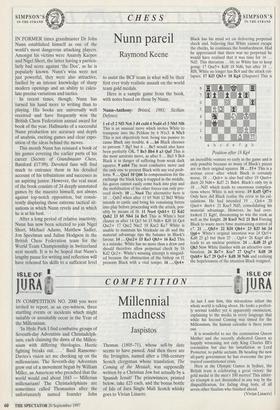St,
SIMPSON'S
IN-THE-STRAND
CHESS
SIMPSON'S
IN-THE-STRAND
Nunn pareil
Raymond Keene
IN IN FORMER times grandmaster Dr John Nunn established himself as one of the world's most dangerous attacking players. Amongst his victims were Anatoly Karpov and Nigel Short, the latter having a particu- larly bad score against 'the Doc', as he is popularly known. Nunn's wins were not just powerful, they were also attractive, fuelled by an intense knowledge of sharp modern openings and an ability to calcu- late precise variations and tactics.
In recent times, though, Nunn has turned his hand more to writing than to playing. His books are universally well received and have frequently won the British Chess Federation annual award for book of the year. Hallmarks of a successful Nunn production are accuracy and depth of analysis, exciting games and clear expo- sition of the ideas behind the moves.
This month Nunn has reissued a book of his games covering the earlier parts of his career (Secrets of Grandmaster Chess, Batsford £17.99). Devoted fans will find much to entrance them in his detailed account of his tribulations and successes as an aspiring junior. However, the real meat of the book consists of 24 deeply annotated games by the maestro himself, not always against top-notch opposition, but consis- tently displaying those extreme tactical sit- uations in which Nunn revels and in which he is at his best.
After a long period of relative inactivity, Nunn has now been selected to join Nigel Short, Michael Adams, Matthew Sadler, Jon Speelman and Julian Hodgson in the British Chess Federation team for the World Team Championship in Switzerland next month. It is to be hoped that Nunn's lengthy pause for writing and reflection will have rehoned his skills to a sufficient level to assist the BCF team in what will be their first ever truly realistic assault on the world team gold medals.
Here is a sample game from the book, with notes based on those by Nunn.
Nunn–Anthony: Bristol, 1981; Sicilian Defence.
1 e4 c5 2 Nf3 Nc6 3 d4 cxd4 4 Nxd4 e5 5 Nb5 Nf6 This is an unusual move which invites White to transpose into the Pelikan by 6 N1c3. 6 N5c3 This is not objectively best, being too passive to cause Black any trouble. 6 ... h6 Black chooses to prevent 7 Bg5 but 6 ... Bc5 would also have been perfectly OK. 7 Be3 Bb4 8 a3 Qa5 This is the most accurate move, as after 8 ... Ba5 9 Bc4 Black is in danger of suffering from weak dark squares. 9 axb4 The most combative move and the only one to present Black with any real prob- lems. 9 ...Qxal 10 Qd6 In compensation for the exchange the black king is trapped in the middle, his queen cannot easily come back into play and the mobilisation of his other forces can only pro- ceed slowly. 10 ...Nxe4 The alternative here is 10 ... Qxb2 when after 11 b5 Nd4 12 Bd3 White intends to castle and bring his remaining forces into play before proceeding with the attack, pos- sibly by means of f4. 11 Nxe4 Qxbl+ 12 Kd2 Qxb2 13 b5 Nb4 14 Bc5 This is White's best chance as after 14 Qc5 b6 15 Nd6+ Kf8 16 Qc4 Qxc2+ 17 Qxc2 Nxc2 18 Kxc2 Ke7 White is unable to maintain his blockade on d6 and the material advantage tips the balance in Black's favour. 14 ...Qxc2+ 15 Ke3 Qb3+ 16 Ke2 This is a mistake. White has no more than a draw and should therefore allow perpetual check by 16 Kd2 Qc2+. White's winning attempt is misguid- ed because the obstruction of the bishop on fl presents Black with a vital tempo. 16 ...Qc4+ Black has his mind set on delivering perpetual check and, believing that White cannot escape the checks, he continues the bombardment. Had he appreciated that there was no perpetual he would have realised that it was time for 16 ... Nd5. This threatens ...b6, so White has to keep going: 17 Qxe5 + Kd8 18 Nd6, but after 18 ... Rf8, White no longer has Bc4 and the attack col- lapses. 17 K13 Qb3+ 18 Kg4 (Diagram) This is
an incredible venture so early in the game and is only possible because so many of Black's pieces are on their original squares. 18 ... f 5 + This is a serious error after which Black is certainly worse. 18 ... Qe6+ is also bad after 19 Qxe6+ dxe6 20 Nd6+ Kd7 21 Bxb4. Black's only try is 18 ... Nd5 which leads to enormous complica- tions where White is not worse. 19 KxfS Q17+ Only here did Black realise the error in his cal- culations. He had intended 19 ... Qe6+ 20 Qxe6+ dxe6+ 21 Kxe5 Nd5, consolidating his material advantage. However, he had over- looked 21 Kg6!, threatening to win the rook as well as the knight. 20 Kxe5 Nc2 21 Bc4 Forcing Black to waste more time maintaining control of e7. 21 ... QhS+ 22 Kf4 Qh4+ 23 Kf3 b6 24 Qg6+ White's original intention was 24 Qe5+ Kd8 25 g3 but then 25 Qg4+ 26 Kxg4 d6+ leads to an unclear position. 24 ...Kd8 25 g3 Qh3 Now White finishes with an attractive com- bination. 26 Be7+ Kxe7 27 Qxg7+ Kd8 28 QxhS+ Kc7 29 Qe5+ Kd8 30 Nd6 and realising the hopelessness of the situation Black resigned.


































































 Previous page
Previous page